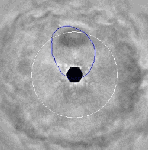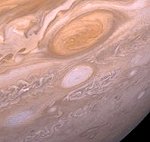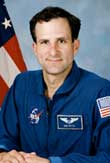| Space Digest | |
| http://www.sina.com.cn 2004/07/29 13:06 新浪教育 | |
语音讲解: By Paul Thompson Broadcast: April 2, 2003 (THEME) VOICE ONE: This is Steve Ember. VOICE TWO:
And this is Bob Doughty with the VOA Special English program EXPLORATIONS. Today we tell about an American astronaut who makes beautiful photographs of space and Earth from the International Space Station. We also tell about a recently discovered dark spot on the planet Jupiter. We report about efforts to produce low cost fuel. And we tell about a new space telescope to be launched April eighteenth. (THEME) VOICE ONE: The American Space Agency, NASA, expects to launch a new space telescope on April eighteenth. It will go into space on a Delta Two rocket from Cape Canaveral, Florida. The new telescope is called the Space Infrared Telescope Facility. It will permit space scientists to see objects that are too cold, distant or covered by dust or clouds for other telescopes to see. The telescope searches the universe for objects that can only be seen by an infrared device that can see infrared light. Infrared light can not be seen by the human eye. British scientist Sir William Herschel discovered infrared radiation in eighteen-hundred. He did this by measuring the temperatures in the colors of solar light as they passed through a piece of glass called a prism. The area just beyond the visible red produced the highest temperature in his experiment. That is the area where there is no visible light. The discovery showed for the first time that there are forms of light which we cannot see with our eyes. VOICE TWO: NASA officials say the new telescope will make about twenty-thousand observations a year. It will look for the infrared radiation given off by objects deep in space. Earth’s atmosphere blocks the infrared radiation of such objects. The telescope can also see objects that are hidden in space by dust clouds or gas. The Space Infrared Telescope Facility will be the largest infrared telescope ever launched into space. It will permit scientists to see into areas of space that are hidden from other telescopes. NASA says the telescope should be able to operate for about thirty months. (MUSIC) VOICE ONE: Scientists have known for many years that if you mix oxygen and hydrogen fuel you can produce electric power. The device that does this is called a fuel cell. Oxygen and hydrogen are two of the most common elements found in nature. Combining oxygen and hydrogen in a fuel cell produces power without producing harmful waste. The only waste produced by a fuel cell is water. This waste product is so clean that astronauts on the space shuttle drink the water produced by fuel cells. The space shuttles are among the few devices that use fuel cells.
NASA scientists are working on problems that must be solved before fuel cells will become common. When that happens, almost any device that needs electric power will be able to use a fuel cell. Fuel cells might be used to power cars, trucks, small computers and even the popular telephones that people carry with them. VOICE TWO: Several companies have already produced automobiles that are powered by fuel cells. However they are very costly to make. Another difficult problem with fuel cells is the extreme temperatures they produce. Fuel cells made today produce temperatures of one-thousand degrees Celsius. Because of this extreme heat, special materials must be used to build fuel cells. VOICE ONE: The Texas Center for Superconductivity and Advanced Materials is part of the University of Houston. Researchers there hope to make a kind of fuel cell that will produce less than half the amount of heat produced by fuel cells used today. The Texas center says producing a fuel cell that can operate at cooler temperatures will be less costly. Researchers like those at the Texas Center are working on six different kinds of fuel cells. Each uses a different method to combine the hydrogen fuel with the oxygen to produce power. All the major automobile companies are developing fuel cell vehicles. They will test several kinds of fuel cells until they find the best one. In January, President Bush asked Congress to approve more than one-thousand-million dollars to help develop this new technology. (MUSIC) VOICE TWO: NASA picture of dark spot on Jupiter. Scientists have been watching a huge object on the planet Jupiter for more than one-hundred years. It is a huge, long-lasting storm called the Great Red Spot. Scientists used to think it was the largest thing on Jupiter. However, images from NASA’s Cassini spacecraft have found something at least as large. NASA scientists are calling this new object the Great Dark Spot. Bob West is a scientist at NASA’s Jet Propulsion Laboratory in Pasadena, California. He says he was completely surprised when he saw the dark object. He says it is dark cloud two times as big as Earth. It is moving around Jupiter’s North Pole. VOICE ONE: Mister West says he first saw evidence of the dark spot in an ultraviolet picture taken by the Hubble Space Telescope in nineteen-ninety-seven. But it only appeared in one image out of many that were taken by the Hubble over several years.
Mister West says he did not know what the dark spot was then. Now he knows. He says the Cassini spacecraft could see Jupiter’s North Pole when it passed the large planet in two-thousand on its way to Saturn. Mister West said photographs sent by Cassini showed the dark spot moving in a circle and changing shape. He says the Cassini spacecraft was able to observe the huge cloud for eleven weeks. VOICE TWO: Red spot in Jupiter's atmosphere. Mister West says the Cassini observations show that the Great Dark Spot and the Great Red Spot are very different. He says the Great Red Spot is deep within the atmosphere of Jupiter. It is a high pressure storm system far below Jupiter’s clouds. The Great Dark Spot is very high in Jupiter’s atmosphere. Mister West says the Great Dark Spot is trapped by fast-moving winds that circle Jupiter’s North Pole. The winds act like a wall, keeping the Great Dark Spot moving in one place. Mister West says that something similar can be found over Earth’s South Pole. Fast-moving winds there keep the ozone hole near the South Pole. Mister West says observing the Great Dark Spot could help scientists understand how these winds control huge objects. He says he would be very happy to have more pictures of Jupiter’s Great Dark Spot. (MUSIC) VOICE ONE: American Astronaut Don Pettit is extremely happy to be a member of the crew of the International Space Station. Mister Pettit has been living and working on the space station since November twenty-fifth, two-thousand. He is a member of the Expedition Six crew and the science officer. Most of the time Mister Pettit is involved in scientific experiments on the space station. However, when he is not working Mister Pettit likes to take photographs. Don Pettit says he always sees something interesting out the window of the space station. He takes photographs of distant stars, galaxies, and the Earth. In the past several weeks, he has been photographing auroras. Auroras are colorful lights in the sky. They are caused by electrons and protons from space that hit Earth’s atmosphere. This action produces red and green colors from oxygen and blue colors from nitrogen. These colors can been seen from Earth in the Northern Hemisphere. They are often called the Northern Lights. VOICE TWO: Mister Pettit says the auroras move slowly across the sky. He says they seem like huge crawling objects that are forever changing. They move, come and go. Sometimes they are topped by huge red structures shaped like feathers. Mister Pettit says the International Space Station flew through an aurora over Canada last January. He said, “The station was surrounded by a red fog. Just below were green rivers of light. I wanted to reach out the window and touch the light. But of course I could not.” VOICE ONE: The auroras are not all Mister Pettit has photographed. He has seen meteors or space rocks fall apart when they hit Earth’s atmosphere. He has also seen satellites and other man-made objects that have been left in space. Mister Pettit recently took some beautiful pictures of stars in the Southern Hemisphere. The stars are called the Large Magellanic Cloud, the Coal Sack Nebula and the Southern Cross. If you have a computer, you can see some of Astronaut Pettit’s photographs. Go to the Web site www.science.nasa.gov/. (THEME) VOICE TWO: This program was written and produced by Paul Thompson. I’m Bob Doughty. VOICE ONE: And I’m Steve Ember. Join us again next week for EXPLORATIONS, a program in Special English on the Voice of America. 出处:《美国之音慢速英语经典》系列光盘产品 BiCulture工作室(www.biculture.com)
| |
| 【英语学习论坛】【评论】【大 中 小】【打印】【关闭】 |


